Three Pinoy kids make a splash at the World Robot Olympiad
By Sheila RamosPhilippine Daily Inquirer
All that hard work paid off as teammates Lucas Ramos, Cristian Ayala and Rom Villarica had a truly unforgettable experience, bonding not only among themselves, but also with kindred spirits from around the world. Geeky as it may sound, they found themselves among peers who shared a passion for building Lego robots and for NXT programming.
Much to their surprise, on their first day at the Abu Dhabi National Exhibitions Company (Adnec), Lucas, Cris and Rom were welcomed by the “rock stars” of the robotics world—Daniele Benedettelli and his Cyclops, Marc-Andre Bazergui and his Wall-E, David Gilday and Mike Dobson and their current Guinness World Record holder CubeStormer II, to name a few. All under one roof, face-to-face, with hands-on demonstrations of what their revered robotic inventions could do.
There was nothing more satisfying than seeing these students interact with their gurus, those truly credited for thinking out of the box and into the future, imagining a community where robots interacted with and assisted
humans in daily functions.
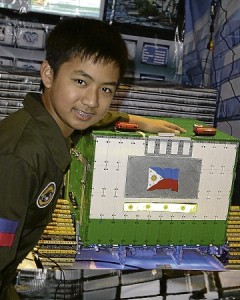
Rock stars
Benedettelli is a world-famous young Italian robotics engineer. His robots have been viewed more than three million times on his YouTube videos. He has written two best-selling books, which feature full building instructions of his robots. He is the first to build the Rubik’s cube solver Rubik Utopia.
In WRO, Benedettelli showcased Cyclops, a complex robot that could walk and turn smoothly, gesticulate, talk, understand natural speech and interact with people by detecting faces and gestures. Truly, it was an honor for the boys that Benedettelli came and sat to watch Lucas, Cris and Rom present their robots.
And then there was Bazergui, a Canadian IT specialist who created one of the more popular robots featured in the WRO. His robot is inspired by and carries the same moniker as the well-loved animated robot Wall-E. Marc built a 20-cm tall Wall-E that transformed from a cube to its cinematic inspiration.
This Wall-E moved around on tracks, had flexible arms and a bobbing head that featured those popular blue telescopic eyes. Lucas and his robotics coach found Bazergui online earlier this year while brainstorming on what robots they could create for the WRO competition. With a robot carrier in mind, Bazergui guided Lucas in creating the CarrierTron, simpler than Wall-E, but with its own unique functions.
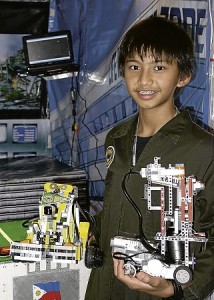
Meeting and chatting with Bazergui made Lucas realize his love for building and figuring out how things moved. This certainly was the highlight of Lucas’ Abu Dhabi adventure, as he found a future mentor.
Throughout the competition, Lucas had in his pocket the two pieces of special Lego bricks Bazergui gave him.
Impressive work
Another impressive work of robotic art and a crowd favorite was CubeStormer II, created by Gilday and Dobson. Last 11-11-11, it set the Guinness World Record for the fastest time for a robot to solve a 3 x 3 x 3 Rubik’s cube, faster than the human world record. During demonstrations at the WRO, it consistently took around five seconds to solve the cube.
And, from robotic art to one robot that actually created art, Sacek’s 3D Milling Machines sculpted 3D faces and shapes with excellent precision. Such fine pieces created out of flower foam took one to two hours to create. Arthur’s machines milled different shapes over the three days that we spent at Adnec.
The possibilities are endless for what robots can be created for, and what these robotic inventions can, in turn, create. There was no better venue to be introduced to all these than at a Robot Olympiad where the minds of close to 1,500 finalists, selected from 15,000 teams from 38 countries, came together to exchange ideas and feast over each other’s creations.
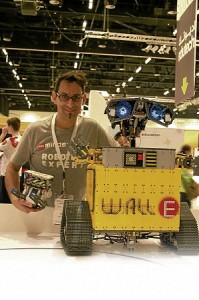
Oh yes, by the way, there was a competition—almost upstaged by the Robotics Rock stars! Definitely worthy of mention is the fifth-place finish, out of 31 entries, of the team of Lucas, Cris and Rom, in the Junior High School Open Category that they competed in.
The highlight of the WRO for Cris was how the five-minute presentation of their robots to the judges was executed nearly flawlessly. Their teamwork and delivery were excellent. The buildup of pressure over the past eight months had been incredibly intense, starting in March when the boys started to plan and build their robots, increasing after they won the gold medal in the Philippine qualifying tilt in September, and intensifying upon their arrival at the gigantic Adnec to see the best robotics kids in the world, all busy getting ready for the big competition.
Global attractions
Though this competition was almost just an excuse to travel together and attend this convention, parents and brothers in tow, the boys were at the top of their game and came well-prepared. Fraser M. Smith, president of Raytheon Sarcos, dropped by to greet and watch the boys strut their stuff. It was Rom who was left in awe by this meeting, as Smith proved to him that one could be both a “hands-on” person and the president of a company.
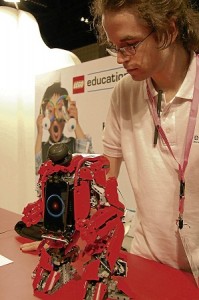
He spoke at length with the boys about Raytheon’s many projects, including a motion-controlled robot that could lift heavy objects with ease. More notable was how Raytheon had built many robots for attractions across the globe, such as the Bellagio fountains display in Las Vegas and the robots for the Jurassic Park and Pirates of the Caribbean theme rides.
Smith handed each of the boys a business card, and it impressed Rom that he was a PhD—something Rom also aspires to be.
Smith is overseeing the creation of human exoskeletons for the US military—the real-life Ironman! Working in Raytheon would certainly be a dream job for the boys.
As Lucas, Cris and Rom made their way back home to Manila, back to school and their day-to-day homework, they now carry with them nuggets of inspiration from their experience at the Robot Olympiad, and a realization that there is a world out there where robots and their creators can thrive side by side.
MALOLOS CITY, Philippines – A team of high school students from this province won fourth place in the annual World Robot Olympiad (WRO) held recently in Abu Dhabi.
The team from Dr. Yanga’s Colleges Inc.(DYCI) in Bocaue town also bagged the Best Technical Design Award for their robot “MAGIS,” which stands for “Man’s All-Around Global Interactive Solutions.”
The DYCI Primes robotics team is composed of Alexandra Mae Guevarra, Claire Receli Reñosa, and Chelsea Andrea Morales. Beryl Cruz is head coach while Romyr Gimeno is assistant coach.
Team members Reñosa and Morales competed for the first time, while Guevarra was part of the DYCI team that bagged the WRO championship last year.
“The competitions were tough and the competitors were very good, but we were glad that we made it to top four in the open category,” said Cruz.
Malaysia, South Africa and South Korea won the first, second and third place, respectively.
The International School of Manila won fifth place in the open category and the Philippine Science High School based in Camarines Sur, won fifth place in Robot Soccer.
Cruz said MAGIS is a robot that has a calamity tracker dog, which could detect flood. It is also has a mini-screen projector for entertainment; e-brail for the elderly who can’t read; a thermometer and blood pressure measuring device; and is also a personal savings machine.
“MAGIS was design to help man in his everyday life, that’s why it also have an amicus program which can play Tic-Tac-Toe with you and he can display happy and sad emotions,” he said.
The award is the third for DYCI in three consecutive years. In 2009, the DYCI team placed ninth in the WRO held in South Korea; and ruled the WRO held at the SMX Convention Center in Pasay City last year. - By Dino Balabo (Philstar News Service, www.philstar.com)
Much to their surprise, on their first day at the Abu Dhabi National Exhibitions Company (Adnec), Lucas, Cris and Rom were welcomed by the “rock stars” of the robotics world—Daniele Benedettelli and his Cyclops, Marc-Andre Bazergui and his Wall-E, David Gilday and Mike Dobson and their current Guinness World Record holder CubeStormer II, to name a few. All under one roof, face-to-face, with hands-on demonstrations of what their revered robotic inventions could do.
There was nothing more satisfying than seeing these students interact with their gurus, those truly credited for thinking out of the box and into the future, imagining a community where robots interacted with and assisted
humans in daily functions.

Rock stars
Benedettelli is a world-famous young Italian robotics engineer. His robots have been viewed more than three million times on his YouTube videos. He has written two best-selling books, which feature full building instructions of his robots. He is the first to build the Rubik’s cube solver Rubik Utopia.
In WRO, Benedettelli showcased Cyclops, a complex robot that could walk and turn smoothly, gesticulate, talk, understand natural speech and interact with people by detecting faces and gestures. Truly, it was an honor for the boys that Benedettelli came and sat to watch Lucas, Cris and Rom present their robots.
And then there was Bazergui, a Canadian IT specialist who created one of the more popular robots featured in the WRO. His robot is inspired by and carries the same moniker as the well-loved animated robot Wall-E. Marc built a 20-cm tall Wall-E that transformed from a cube to its cinematic inspiration.
This Wall-E moved around on tracks, had flexible arms and a bobbing head that featured those popular blue telescopic eyes. Lucas and his robotics coach found Bazergui online earlier this year while brainstorming on what robots they could create for the WRO competition. With a robot carrier in mind, Bazergui guided Lucas in creating the CarrierTron, simpler than Wall-E, but with its own unique functions.

Meeting and chatting with Bazergui made Lucas realize his love for building and figuring out how things moved. This certainly was the highlight of Lucas’ Abu Dhabi adventure, as he found a future mentor.
Throughout the competition, Lucas had in his pocket the two pieces of special Lego bricks Bazergui gave him.
Impressive work
Another impressive work of robotic art and a crowd favorite was CubeStormer II, created by Gilday and Dobson. Last 11-11-11, it set the Guinness World Record for the fastest time for a robot to solve a 3 x 3 x 3 Rubik’s cube, faster than the human world record. During demonstrations at the WRO, it consistently took around five seconds to solve the cube.
And, from robotic art to one robot that actually created art, Sacek’s 3D Milling Machines sculpted 3D faces and shapes with excellent precision. Such fine pieces created out of flower foam took one to two hours to create. Arthur’s machines milled different shapes over the three days that we spent at Adnec.
The possibilities are endless for what robots can be created for, and what these robotic inventions can, in turn, create. There was no better venue to be introduced to all these than at a Robot Olympiad where the minds of close to 1,500 finalists, selected from 15,000 teams from 38 countries, came together to exchange ideas and feast over each other’s creations.

Oh yes, by the way, there was a competition—almost upstaged by the Robotics Rock stars! Definitely worthy of mention is the fifth-place finish, out of 31 entries, of the team of Lucas, Cris and Rom, in the Junior High School Open Category that they competed in.
The highlight of the WRO for Cris was how the five-minute presentation of their robots to the judges was executed nearly flawlessly. Their teamwork and delivery were excellent. The buildup of pressure over the past eight months had been incredibly intense, starting in March when the boys started to plan and build their robots, increasing after they won the gold medal in the Philippine qualifying tilt in September, and intensifying upon their arrival at the gigantic Adnec to see the best robotics kids in the world, all busy getting ready for the big competition.
Global attractions
Though this competition was almost just an excuse to travel together and attend this convention, parents and brothers in tow, the boys were at the top of their game and came well-prepared. Fraser M. Smith, president of Raytheon Sarcos, dropped by to greet and watch the boys strut their stuff. It was Rom who was left in awe by this meeting, as Smith proved to him that one could be both a “hands-on” person and the president of a company.

He spoke at length with the boys about Raytheon’s many projects, including a motion-controlled robot that could lift heavy objects with ease. More notable was how Raytheon had built many robots for attractions across the globe, such as the Bellagio fountains display in Las Vegas and the robots for the Jurassic Park and Pirates of the Caribbean theme rides.
Smith handed each of the boys a business card, and it impressed Rom that he was a PhD—something Rom also aspires to be.
Smith is overseeing the creation of human exoskeletons for the US military—the real-life Ironman! Working in Raytheon would certainly be a dream job for the boys.
As Lucas, Cris and Rom made their way back home to Manila, back to school and their day-to-day homework, they now carry with them nuggets of inspiration from their experience at the Robot Olympiad, and a realization that there is a world out there where robots and their creators can thrive side by side.
Bulacan students win 4th place in World Robot Olympiad
Philippine Star
27 November 2011
The team from Dr. Yanga’s Colleges Inc.(DYCI) in Bocaue town also bagged the Best Technical Design Award for their robot “MAGIS,” which stands for “Man’s All-Around Global Interactive Solutions.”
The DYCI Primes robotics team is composed of Alexandra Mae Guevarra, Claire Receli Reñosa, and Chelsea Andrea Morales. Beryl Cruz is head coach while Romyr Gimeno is assistant coach.
Team members Reñosa and Morales competed for the first time, while Guevarra was part of the DYCI team that bagged the WRO championship last year.
“The competitions were tough and the competitors were very good, but we were glad that we made it to top four in the open category,” said Cruz.
Malaysia, South Africa and South Korea won the first, second and third place, respectively.
The International School of Manila won fifth place in the open category and the Philippine Science High School based in Camarines Sur, won fifth place in Robot Soccer.
Cruz said MAGIS is a robot that has a calamity tracker dog, which could detect flood. It is also has a mini-screen projector for entertainment; e-brail for the elderly who can’t read; a thermometer and blood pressure measuring device; and is also a personal savings machine.
“MAGIS was design to help man in his everyday life, that’s why it also have an amicus program which can play Tic-Tac-Toe with you and he can display happy and sad emotions,” he said.
The award is the third for DYCI in three consecutive years. In 2009, the DYCI team placed ninth in the WRO held in South Korea; and ruled the WRO held at the SMX Convention Center in Pasay City last year. - By Dino Balabo (Philstar News Service, www.philstar.com)
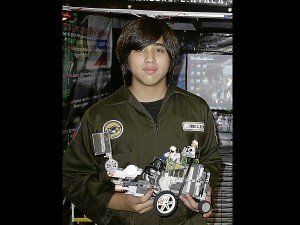
No comments:
Post a Comment